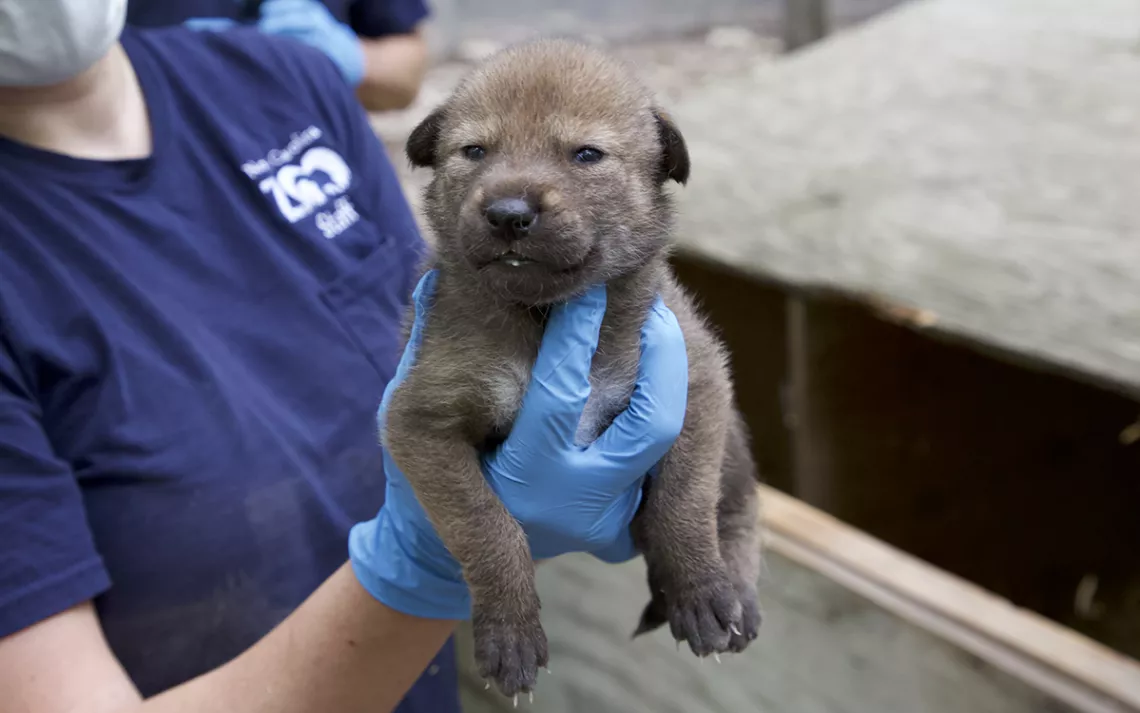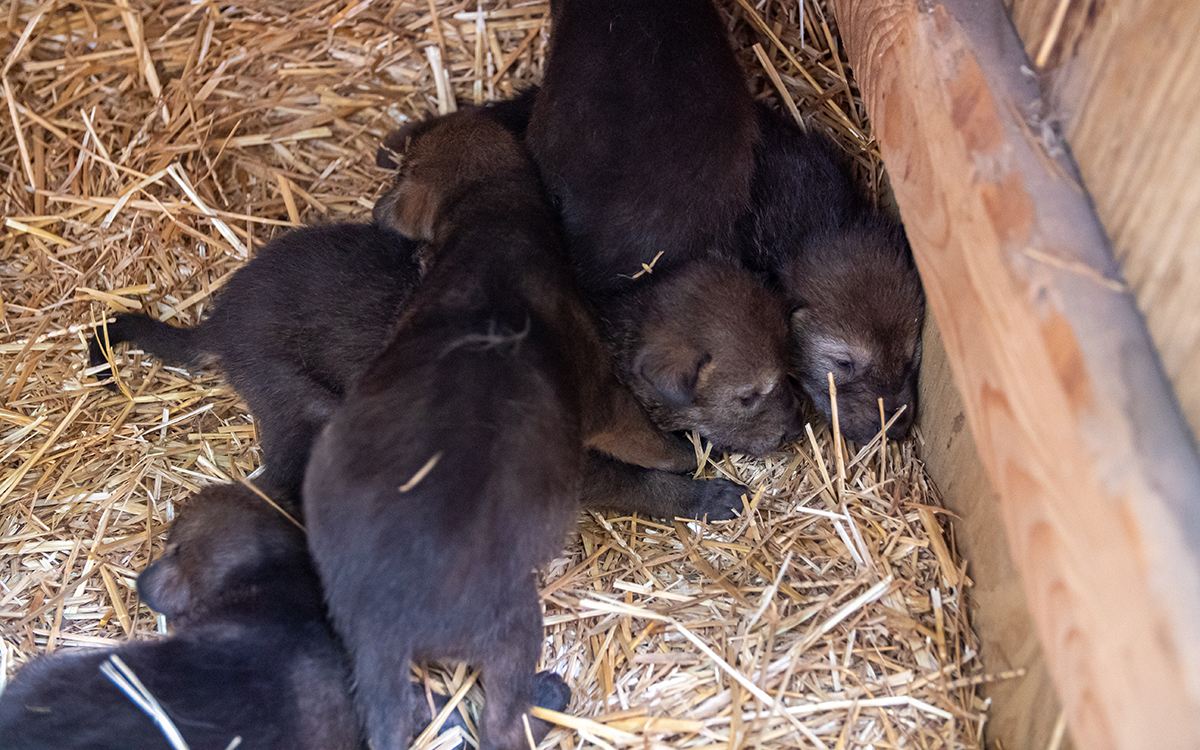Is the US Fish and Wildlife Service Slow-Walking Red Wolf Recovery?
Critics say the agency is moving too slowly to save the animal from extinction

Photos courtesy of North Carolina Zoo
Last spring, amid grim headlines about the coronavirus, some heartwarming news received national attention. Seven red wolves were born in April and May at the North Carolina Zoo. Images of Lily, Aster, Cedar, Sage, and their siblings, all named after plants native to the state, circulated widely on social media.
About 250 red wolves live in 43 zoos, wildlife sanctuaries, and other refuges throughout the US. A sophisticated captive-breeding program, in partnership with the US Fish and Wildlife Service (USFWS), even includes a stud book of wolves to help ensure genetic diversity.
But in the wild, America’s native wolf remains one of the country’s most endangered species. Only nine red wolves are known to roam a five-county area of northeastern North Carolina, all of them tracked through radio collars. USFWS estimates another 10 or so live in the territory. No wild litters have been born for two years.
USFWS has taken some steps to help the wild red wolf—but not nearly enough and not quickly enough, according to advocates for the wolf. Several recent lawsuits underscore their belief that USFWS, through its lack of urgent action, is essentially letting the wild species die out. Losing the wolves now would be especially galling given that USFWS successfully rebuilt the wild population from extinction in 1980 up to roughly 130 animals by the late 2000s.
The Southern Environmental Law Center, on behalf of three conservation groups, announced in September that it plans to sue USFWS over red wolf policies in North Carolina that violate the Endangered Species Act. USFWS has “proven methods and tools to recover this iconic species," says Southern Environmental Law Center attorney Ramona McGee. Yet USFWS has stopped the release of captive wolf pups into wild dens as well as coyote sterilizations to prevent mixed-species pups and other beneficial strategies. Through the lawsuit, plaintiffs hope to force USFWS into resuming these techniques to save the species in the wild.
Wild red wolves once ranged the Southeast, East Coast, and as far west as Texas. Beyond the dwindling group of wolves in North Carolina, there’s the question of when USFWS will identify other spots in the wolf’s historic range where it might be reintroduced. Those sites could be part of USFWS’s Red Wolf Recovery Plan, but the agency hasn’t updated the plan since 1995. Last winter, the Center for Biological Diversity took USFWS to court over the lack of a current plan. According to the settlement agreement, which was approved just this week, USFWS has until February 2023 to create a new plan.
USFWS has already lost a separate lawsuit over the wolves—in November 2018, Judge Terrence Boyle lambasted the USFWS for violating the Endangered Species Act in its red wolf management practices. His ruling made it illegal for private landowners to shoot the wolves unless USFWS can prove a wolf is a demonstrated danger to humans, livestock, or pets. Red wolves typically aren't aggressive toward people and tend to keep to themselves.
After that ruling, USFWS announced it would “review” rule changes it had proposed to significantly shrink the wolves’ territory in North Carolina. That review is officially still going on. And USFWS has only doubled-down on its claim that it’s barred from releasing wolves from captivity “despite having done precisely that for several decades previously,” McGee says.
Landowners and North Carolina officials who oppose red wolf reintroduction have tried to argue that the red wolves have interbred with coyotes too much to merit protection under the Endangered Species Act. They persuaded Congress to commission a study on whether the wolves are a distinct species, but the National Academies of Sciences, Engineering, and Medicine confirmed in March 2019 that the red wolf is indeed unique. This means the federal government is still required to defend it against extinction.
“Wolf numbers have plummeted, and for at least five years only one wolf has been released into the recovery area,” says Heather Clarkson, an advocate with the conservation group Defenders of Wildlife. That lone wolf, a male from St. Vincent National Wildlife Refuge in Florida, was paired this last winter with a female in hopes they would produce pups. Unfortunately, none resulted. USFWS officials say that they may transfer several more wolves from St. Vincent into northeastern North Carolina this coming winter to try again.
USFWS has recently undertaken some new efforts to protect the red wolf. In July, it launched a program with the North Carolina Wildlife Federation called Prey for the Pack to entice landowners in a five-county area to coexist with the wolves.
Prey for the Pack provides landowners with technical assistance and financial incentives for habitat improvements, such as native vegetation plantings and wetland enhancement. Through a cost-sharing arrangement, USFWS will help pay for upgrades that attract quail, turkey, white-tailed deer, or other prey species, providing an incentive for landowners who like to hunt on their property (those who don’t hunt may be motivated to join the program by the offer of cash and technical know-how). All must agree in return not to harass red wolves on their land and to maintain the habitat improvements for 10 years.
The goal, says Joe Madison, program manager for USFWS's Red Wolf Recovery Program in Manteo, North Carolina, is to encourage landowners to view red wolves as a benefit rather than a nuisance or a perceived threat, and get work done on their property that they wanted to do anyway. “I'm hoping that's a way to build a better rapport with some of the larger private landowners,” he says.
Advocates for the red wolf differ on whether the program will be effective. It “could be a great tool to help improve local opinions about red wolves and the USFWS,” says Kim Wheeler, executive director of the Columbia, North Carolina–based Red Wolf Coalition. “The USFWS has to find a way to engage with local landowners and encourage involvement in red wolf conservation.” She sees Prey for the Pack as “a good starting point.”

Perrin de Jong, staff attorney with the Center for Biological Diversity, is more skeptical. With significant public buy-in, the wild population could benefit from an increase in prey species and other protections, he says. But he notes the program is voluntary and “does nothing to address any of the primary drivers of the wild population's collapse,” including genetic threats from encroaching coyotes, lack of suitable mates, intentional killing—for which de Jong says there have been no prosecutions—and “zero effort to secure new habitat for the species across the region.”
Madison disputes the premise that USFWS isn’t invested in the few wild red wolves that remain. “We are fighting the fight every day to keep on establishing and grow this population here in North Carolina. That's what we're focused on,” he says. He also says USFWS, with other groups, is considering whether to resume coyote sterilization on private land to prevent hybrid coyote-wolf pups. Ultimately, he adds, “the whole intention is to have multiple reintroduction sites so that you have populations in multiple areas” to make the species “less susceptible to catastrophic events.”
If the red wolf is going to be allowed to expand outside its current range, private property owners are more likely to be convinced the wolves are not a threat if they see North Carolina successfully managing potential conflicts between wolves and landowners. Wheeler believes there is already more local support for red wolf conservation than people realize. "While there's a 'loud minority of folks against the program that takes every opportunity to express their opinions,'" she says, there are more who appreciate having the world’s only wild population of red wolves in their backyards and understand the need to preserve this native predator to maintain ecological balance.
Beyond the North Carolina initiative, red wolves need a current recovery plan and management strategy to thrive. USFWS says that updating the Red Wolf Recovery Plan is a priority and has contracted the Conservation Planning Specialist Group (CPSG), a global network of conservation professionals, to provide analysis and recommendations for the plan.
CPSG senior program officer Philip Miller says the group will analyze threats and opportunities for the wolf and create a variety of scenarios through computer modeling. Once it identifies what’s best biologically to boost the wolf’s numbers, the group will tackle two important questions, Miller says: “What are the management alternatives that can actually be implemented on the ground, and how do you get buy-in from all of the different stakeholders?” Miller was involved in a similar project for the Mexican wolf in the Southwest US, which led to a revised recovery plan in 2017. At present, the Mexican wolf is faring better than its red wolf cousins, with more than 160 in the wild.
As of now, USFWS must release an updated plan for red wolf recovery by February 2023, as stipulated in the settlement agreement with the Center for Biological Diversity. When asked if the plan might be finished any earlier, USFWS said in a statement that it generally takes 18 to 24 months to gather and synthesize data for a recovery plan, and as it works with CPSG, “timelines associated with the project will be established.”
But time is running out for the wild wolves in the Tar Heel State. "While this is an important step in the long-term, under the status quo, we will not have any wild red wolves in North Carolina by 2023," says McGee of the Southern Environmental Law Center. "A recovery plan several years in the future will not address the urgent, present-day needs of the handful of known remaining wild red wolves. They need help now."
In the coming year, the captive-breeding program will continue to serve as “an assurance population” for when USFWS is ready to launch a more extensive recovery effort, says program coordinator Chris Lasher. It may even grow slightly, to 265 captive wolves. Lasher believes more education is key to help Americans appreciate the red wolf as part of our natural heritage. We were once responsible for eradicating the wolf. We might still bring it back.
“People see a bald eagle fly overhead and get that feeling—‘Wow, that's a bald eagle,'” he says. “I want people to feel the same way about the American red wolf.” When more people experience that sense of awe, that’s the day when “recovery programs will actually have a chance.”
 The Magazine of The Sierra Club
The Magazine of The Sierra Club



